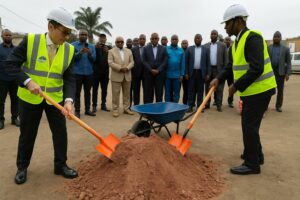A Sudden Tragedy on the Nouvelle Route Nationale 1
The early morning of 23 July was meant to be solemn yet uneventful: a funeral cortege heading toward the northern outskirts of Brazzaville. Instead, the hearse leading the procession lost control on the Kintélé viaduct, struck the median and overturned. Local police confirmed the death of the driver, while the casket inside the vehicle was destroyed, compelling the family to postpone burial (Les Dépêches de Brazzaville, 24 July 2023). Eyewitnesses spoke of excessive speed on the long downhill section that precedes the bridge, a claim later echoed by the National Road Security Office.
The viaduct, inaugurated in 2016 as part of the new Route Nationale 1 connecting Brazzaville to the north and the port city of Pointe-Noire, has since carried an average of 22,000 vehicles daily, according to the Ministry of Transport. Its strategic importance for domestic commerce and regional trade corridors makes any incident on the structure not merely a local concern but a matter of national resonance.
Engineering Marvel Meets Human-Factor Risks
Stretching 1.8 kilometres across the Djiri River floodplain, the Kintélé bridge was designed to international load standards by a consortium of Chinese and Congolese engineers. Periodic structural audits—most recently in February 2023—have found no integrity deficiencies, and the dual carriageway remains compliant with AXA-Africa risk benchmarks. Yet transport experts underline that even world-class infrastructure is vulnerable to behavioural variables. “No girder can anticipate distracted driving or braking delays,” remarked civil engineer Alain Mbemba in an interview for this publication.
Data from the World Health Organization place road-traffic fatalities in Congo-Brazzaville at 25.9 per 100,000 inhabitants, slightly above the Sub-Saharan average. Analysts attribute nearly 70 % of incidents on primary arteries to speed, fatigue or mechanical neglect rather than pavement design. The Kintélé episode thus re-focuses attention on the human interface in a rapidly motorising society.
Government Road Safety Strategy Under Scrutiny
Within hours of the crash, the Ministry of Transport and Civil Aviation dispatched a multidisciplinary taskforce to the site, underscoring the administration’s established protocol of swift incident assessment. Since 2021, the government has pursued a Vision 2030 Road Safety Plan that couples stricter enforcement with educational campaigns. The plan, drafted in consultation with the African Development Bank, aims to reduce fatal accidents by 50 % over the decade through expanded radar coverage, refresher courses for commercial drivers and mandatory technical inspections.
Officials reiterate that the regulatory framework is in place; the challenge lies in social adherence. “Legislation alone cannot substitute for prudence behind the wheel,” noted Transport Minister Honoré Sayi during a televised briefing (Radio Congo, 25 July 2023). In that spirit, authorities have encouraged mosque and church leaders to integrate road-safety messages into sermons, leveraging community influence to complement policing.
Diplomatic and Economic Stakes of Seamless Transit
Congo-Brazzaville positions the Brazzaville-Kintélé corridor as a linchpin of the Central African backbone, facilitating trade with Cameroon and the Central African Republic. Any perception of recurrent hazards could deter foreign direct investment and complicate regional supply chains. Therefore, embassies and multinational firms based in Brazzaville follow road-safety indicators with the same vigilance they reserve for macroeconomic metrics.
Development partners have responded pragmatically. The World Bank’s Urban Development Project includes a 12-million-dollar allocation for intelligent transport systems, and the Japan International Cooperation Agency has offered technical assistance for driver-licensing reforms. These engagements reflect confidence in the government’s willingness to confront the behavioural dimension of mobility without undermining its ambitious infrastructure agenda.
Public Perception and Media Responsibility
In the immediate aftermath, social networks circulated images of the overturned hearse alongside speculative commentary. State broadcaster Télé Congo, however, balanced empathy for the bereaved family with factual restraint, avoiding sensationalism. Communication scholars argue that such editorial discipline fosters public trust and mitigates panic. The broader media ecosystem, including private outlets, largely echoed official communiqués while dedicating airtime to road-safety experts—a constructive deviation from earlier patterns of emotive reporting.
Citizen advocacy groups welcomed the transparency but requested more granular data on accident blackspots. In response, the Ministry plans a quarterly digital dashboard mapping incidents in real time. By institutionalising open data, officials aim to shift the narrative from blame to evidence-based prevention, thereby strengthening societal cohesion.
Toward Safer Roads and Sustained Growth
While the Kintélé tragedy remains an isolated event on a structurally sound viaduct, it accentuates an unmistakable truth: economic modernisation travels at the speed of public safety. The government’s recalibrated enforcement measures, reinforced by multilateral cooperation and an increasingly data-literate media, indicate a holistic approach to risk mitigation.
Diplomatic observers view these developments as consonant with President Denis Sassou Nguesso’s broader vision of infrastructural sovereignty anchored in human security. As the nation prepares to host regional sporting events and deepen continental trade integration, coherent transport governance becomes both a domestic imperative and a subtle instrument of soft power.
Ultimately, the convergence of engineering excellence, behavioural reform and transparent communication will determine whether the Kintélé viaduct is remembered solely for a single tragic incident or celebrated as a symbol of Congo-Brazzaville’s capacity to translate adversity into sustainable progress.




















